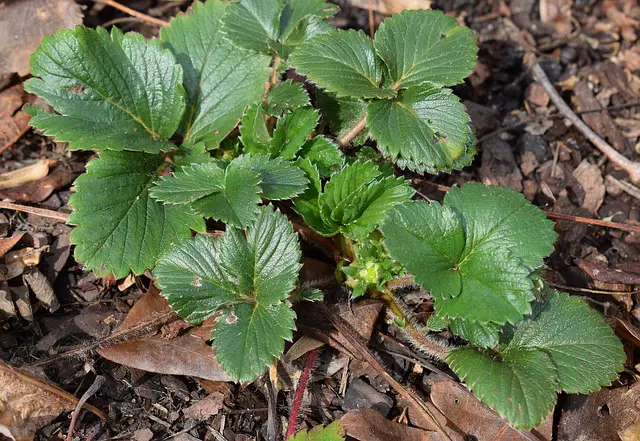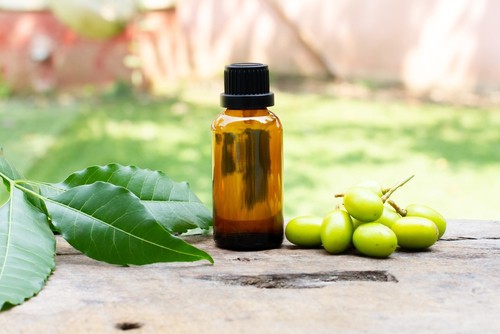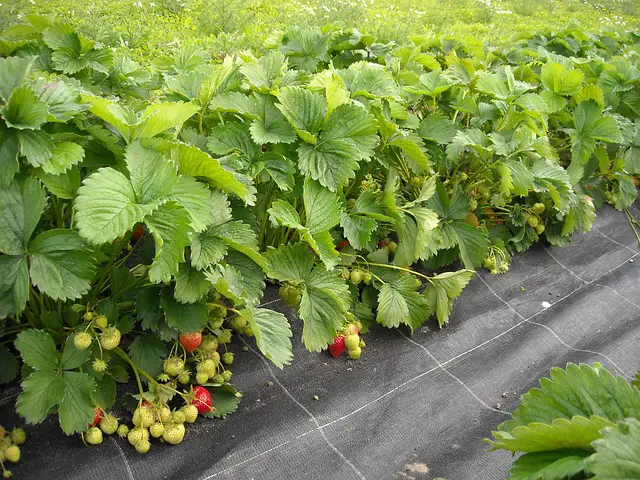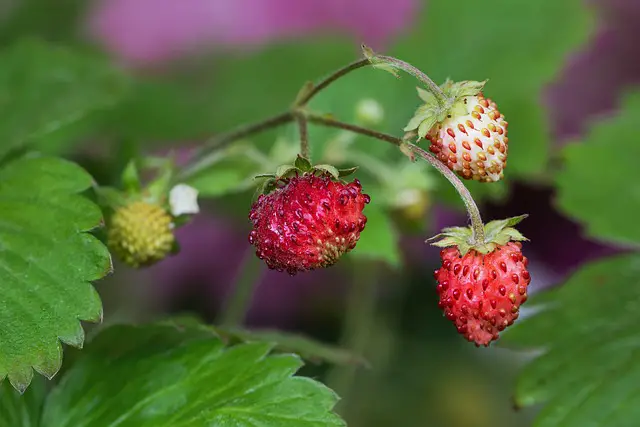Strawberry plants are a popular choice for gardeners and farmers alike, producing sweet and juicy berries throughout the growing season.
However, yellowing leaves on strawberry plants can be a sign of trouble, indicating that the plant is not receiving the nutrients it needs to thrive. Understanding the causes of yellow leaves on strawberry plants is crucial to preventing and treating the issue.
There are several common causes of yellowing leaves on strawberry plants, including a lack of nutrients, overwatering, pest attacks, and fungal diseases.
Identifying the specific issue causing yellow leaves is essential to determining the most effective treatment method. In some cases, prevention is the best approach, ensuring that strawberry plants receive the right amount of water, nutrients, and sunlight to remain healthy.
Key Takeaways on Yellowing Strawberry Plant Leaves
- Yellowing leaves on strawberry plants can be a sign of trouble, indicating that the plant is not receiving the nutrients it needs to thrive.
- Common causes of yellow leaves on strawberry plants include a lack of nutrients, overwatering, pest attacks, and fungal diseases.
- Identifying the specific issue causing yellow leaves is essential to determining the most effective treatment method.
Also don’t miss:
Understanding Strawberry Plant Leaves Turning Yellow

Strawberry plants are known for their sweet and juicy fruits, but sometimes their leaves can turn yellow, indicating that something is wrong. Understanding why strawberry plant leaves turn yellow can help you identify the problem and take corrective measures to ensure that your plants stay healthy and productive.
Identifying Yellow Leaves
Yellow leaves on a strawberry plant are a clear indication that something is amiss. However, it’s important to note that not all yellow leaves are the same. The appearance of the yellow leaf can provide clues as to what is causing the problem.
Some yellow leaves may be uniformly yellow, while others may have green veins. Some may have brown or black spots, while others may be curling or wilting. By closely examining the appearance of the yellow leaves, you can narrow down the possible causes.
Possible Causes of Yellow Leaves
There are several reasons why strawberry plant leaves may turn yellow. Some of the most common causes include:
- Lack of nutrients: Strawberry plants require a balance of nutrients to grow and produce fruit. A lack of nitrogen, phosphorus, or potassium can cause the leaves to turn yellow.
- Overwatering or underwatering: Too much or too little water can stress the plant and cause the leaves to turn yellow.
- Pest or disease infestation: Pests like spider mites and diseases like angular leaf spot can cause the leaves to turn yellow.
- Environmental stress: Heat, cold, and other environmental factors can stress the plant and cause the leaves to turn yellow.
Corrective Measures
Once you have identified the cause of the yellow leaves, you can take corrective measures to restore the plant to health. Some possible solutions include:
- Adjusting nutrient levels: If the plant is lacking nutrients, you can adjust the soil pH or add fertilizer to provide the necessary nutrients.
- Adjusting watering: If the plant is being overwatered or underwatered, you can adjust the watering schedule or improve drainage.
- Treating pests or diseases: If the plant is infested with pests or diseases, you can use an appropriate pesticide or fungicide to treat the problem.
- Protecting from environmental stress: If the plant is being stressed by environmental factors, you can provide shade, mulch, or other protective measures to help the plant recover.
Yellowing Strawberry Plant Leaves – 7 Common Problems
Strawberry plants are known for their vibrant green leaves, but when those leaves start turning yellow, it can be a sign that something is wrong. Here are some common causes of yellowing leaves in strawberry plants:
1. Nutrient Deficiencies

Strawberry plants require a balanced mix of nutrients to grow healthy leaves and fruit. If the soil lacks essential nutrients like nitrogen, phosphorus, or potassium, the plant may develop yellow leaves.
Nitrogen deficiency is especially common and can cause the leaves to turn pale yellow or even white. To fix this issue, gardeners can apply a nitrogen-rich fertilizer to the soil.
2. Overwatering and Underwatering
Strawberry plants need consistent moisture to thrive, but overwatering or underwatering can cause the leaves to turn yellow. When the soil is too wet, the roots can become waterlogged and start to rot, which can lead to yellow leaves.
On the other hand, when the soil is too dry, the plant may not be able to absorb enough nutrients, causing the leaves to wilt and turn yellow. Gardeners should aim to keep the soil consistently moist but not waterlogged.
3. Fungal Diseases
Fungal diseases like root rot and leaf spot can also cause yellowing leaves in strawberry plants. These diseases thrive in moist environments and can spread quickly if left untreated.
To prevent fungal diseases, gardeners should avoid overwatering and ensure good air circulation around the plants. If a plant does become infected, gardeners can use a fungicide to treat the issue.
4. Extreme Temperatures
Strawberry plants are sensitive to extreme temperatures, and both hot and cold weather can cause the leaves to turn yellow. In hot weather, the plant may become stressed and start to wilt, while in cold weather, the leaves may turn yellow and drop off.
Gardeners should try to keep the plants in a location with moderate temperatures and protect them from extreme weather conditions.
5. Transplant Shock
When a strawberry plant is transplanted, it can go into shock and develop yellow leaves. This is a natural response to the stress of being uprooted and moved to a new location. Gardeners should take care to transplant strawberry plants carefully and provide them with plenty of water and nutrients to help them recover from the shock.
6. Poor Soil Conditions
Strawberry plants need well-draining soil with a pH between 5.5 and 6.5 to grow healthy leaves and fruit. If the soil is too acidic or too alkaline, the plant may develop yellow leaves. Gardeners can test the soil pH and adjust it as needed with amendments like lime or sulfur.
7. Pests
Pests like aphids and spider mites can suck the sap from strawberry plants, causing the leaves to turn yellow. Gardeners should inspect their plants regularly and treat any pest infestations promptly with insecticidal soap or neem oil.
Identifying Specific Issues

When strawberry plant leaves turn yellow, it can be a sign of several specific issues. Identifying the cause of the yellowing can help in determining the best course of action to take. Here are some common issues that can cause yellowing of strawberry plant leaves:
1. Leaf Scorch
Leaf scorch is a common issue that can cause yellowing of strawberry plant leaves. It occurs when the leaves are exposed to too much direct sunlight or heat. The edges of the leaves will turn brown and dry out, and the yellowing will usually start at the edges and work its way inward.
To prevent leaf scorch, it’s important to ensure that the plants are getting enough water and that they are not exposed to too much direct sunlight.
2. Powdery Mildew
Powdery mildew is a fungal disease that can cause yellowing of strawberry plant leaves. It appears as a white or gray powder on the leaves and can spread quickly. The leaves may also become distorted or curled. To prevent powdery mildew, it’s important to keep the plants well-ventilated and to avoid overhead watering.
3. Root Rot
Root rot is a fungal disease that can cause yellowing of strawberry plant leaves. It occurs when the roots of the plant become waterlogged and begin to rot. The leaves may also wilt and turn brown. To prevent root rot, it’s important to ensure that the plants are not overwatered and that the soil has good drainage.
4. Leaf Spot
Leaf spot is a fungal disease that can cause yellowing of strawberry plant leaves. It appears as brown or purple spots on the leaves and can spread quickly. The leaves may also become distorted or curled. To prevent leaf spot, it’s important to keep the plants well-ventilated and to avoid overhead watering.
5. Verticillium Wilt
Verticillium wilt is a fungal disease that can cause yellowing of strawberry plant leaves. It occurs when the plant is infected with a fungus that attacks the roots and causes the leaves to wilt and turn yellow. To prevent verticillium wilt, it’s important to ensure that the plants are not overwatered and that the soil has good drainage.
6. Iron Deficiency
Iron deficiency can cause yellowing of strawberry plant leaves. It occurs when the plant is not getting enough iron, which is essential for the production of chlorophyll. The leaves may also become pale and the veins may turn green.
To prevent iron deficiency, it’s important to ensure that the plants are getting enough iron and other essential nutrients.
Preventing Yellow Leaves in Strawberry Plants

Preventing yellow leaves in strawberry plants is essential to ensure the health and productivity of the plants. Here are some tips to prevent yellow leaves in strawberry plants:
1. Care and Maintenance
Strawberry plants require regular care and maintenance to stay healthy and productive. This includes regular watering, fertilizing, and pruning. A well-maintained strawberry plant is less likely to develop yellow leaves.
2. Mulch
Straw mulch is an excellent way to prevent yellow leaves in strawberry plants. Straw mulch helps to regulate soil temperature, retain moisture, and suppress weed growth. It also helps to keep the soil healthy and fertile, which is essential for the growth of healthy strawberry plants.
3. Compost
Compost is an excellent source of nutrients for strawberry plants. Adding compost to the soil can help to prevent yellow leaves by providing the plants with the necessary nutrients they need to stay healthy.
4. Irrigation
Proper irrigation is essential to prevent yellow leaves in strawberry plants. Strawberry plants require regular watering, but it is important not to overwater them. A regular watering schedule, using a drip or soaker hose, can help to ensure that the plants receive the right amount of water.
5. Well-Drained Soil
Strawberry plants require well-drained soil to prevent yellow leaves. Poorly drained soil can lead to waterlogged roots, which can cause yellow leaves and other problems. It is important to ensure that the soil is well-drained and that the plants are not overcrowded.
6. Growing Conditions
Growing conditions are essential to prevent yellow leaves in strawberry plants. Strawberry plants require full sun and good air flow to stay healthy. Overcrowding can lead to poor air flow, which can cause yellow leaves. It is important to ensure that the plants are spaced out properly and that they receive enough sunlight.
Treating Yellow Leaves in Strawberry Plants

Yellow leaves in strawberry plants can be a sign of several issues, including nutrient deficiencies, pests, diseases, or environmental stress. Treating yellow leaves in strawberry plants is essential to ensure proper growth, yield, and overall plant health.
One effective treatment for yellow leaves in strawberry plants is to prune off the affected leaves and stems. This can help to remove any diseased or damaged plant tissue and promote new growth. However, pruning should be done carefully to avoid damaging healthy parts of the plant.
Another treatment option for yellow leaves in strawberry plants is to use neem oil. Neem oil is a natural pesticide that can help to control pests such as aphids, spider mites, and whiteflies, which can cause yellowing of leaves. Neem oil can also help to prevent the spread of diseases in strawberry plants.
To recover yellow leaves in strawberry plants, it is important to address any nutrient deficiencies. Adding fertilizer that contains nitrogen, phosphorus, and potassium can help to promote chlorophyll production, which is essential for photosynthesis and healthy plant growth.
However, it is important not to over-fertilize, as this can lead to stunted growth, wilting, and other stress-related issues. In addition to addressing nutrient deficiencies, it is also important to address any environmental stressors that may be causing yellow leaves in strawberry plants.
This can include factors such as inadequate watering, poor soil quality, extreme temperatures, or excessive sunlight exposure. Providing adequate water, shade, and nutrients can help to reduce stress and promote healthy plant growth.
Growing Strawberries in Different Conditions
Containers and Garden Beds
Strawberries can be grown in containers or garden beds, depending on the space and resources available. Garden beds are ideal for larger strawberry patches, while containers are better suited for smaller areas or for those who want to move their plants around.
When growing strawberries in containers, choose a pot that is at least 12 inches deep and wide. Make sure the container has drainage holes to prevent water from accumulating and causing root rot.
In garden beds, strawberries should be planted in well-draining soil with a pH between 5.5 and 6.5. The soil should be enriched with organic matter, such as compost or aged manure, to provide the necessary nutrients for optimal growth. Strawberries should be planted in rows with a spacing of 12 to 18 inches between plants.
Winter Care

Strawberries are cold-hardy plants, but they still require some winter care to protect them from frost damage. In colder regions, garden beds should be mulched with straw or leaves to insulate the plants and prevent the soil from freezing.
In containers, the plants should be moved indoors or to a sheltered location to protect them from freezing temperatures.
Sandy and Clay Soils
Strawberries can be grown in a variety of soil types, but sandy and clay soils require special attention. Sandy soils drain quickly and do not retain moisture well, which can cause the plants to dry out. Clay soils, on the other hand, retain water and can cause root rot if the soil is not well-draining.
To grow strawberries in sandy soils, add organic matter such as compost or peat moss to improve water retention. In clay soils, add sand or perlite to improve drainage. In both cases, it is important to monitor the soil moisture levels and adjust watering accordingly.
Conclusion
There are several reasons why strawberry plant leaves may turn yellow. Nutrient deficiency, especially nitrogen, is a common cause. Providing the plant with the necessary nutrients can help prevent yellowing leaves.
Additionally, pests such as nematodes can cause yellowing leaves, and it is important to ensure that plants are free of these pests before planting.
Another possible cause of yellowing leaves is disease, such as angular leaf spot caused by the bacteria Xanthomonas fragariae. Proper sanitation practices and planting disease-resistant varieties can help prevent the spread of disease.
It is important to regularly inspect strawberry plants for signs of yellowing leaves and address any issues promptly to prevent further damage to the plant and potential loss of fruit yield.
By providing the plant with the necessary nutrients, preventing pests and disease, and maintaining good plant hygiene, gardeners can help ensure healthy, vibrant strawberry plants with green leaves and a bountiful harvest.
Frequently Asked Questions
How to fix nitrogen deficiency in strawberry plants?
Nitrogen deficiency is a common cause of yellowing leaves in strawberry plants. To fix this issue, a fertilizer high in nitrogen should be added to the soil.
This will help the plant to produce more chlorophyll, which will turn the leaves green again. However, it is important not to over-fertilize the plant, as this can cause other problems.
What does overwatered strawberries look like?
Overwatered strawberry plants may have yellow leaves that are soft and limp. The soil may also be waterlogged, and the plant may have a weak root system. In severe cases, the plant may die due to root rot.
How often should you water strawberry plants?
Strawberry plants should be watered when the soil feels dry to the touch. It is important not to overwater the plant, as this can cause root rot and other problems. In general, strawberry plants need about 1-2 inches of water per week.
Should I remove yellow leaves from strawberry plants?
Yellow leaves on a strawberry plant may be a sign of a nutrient deficiency or other problem. However, it is not always necessary to remove them. If the plant is otherwise healthy, it may be able to recover on its own.
However, if the yellow leaves are accompanied by other symptoms, such as wilting or stunted growth, it may be necessary to remove them.
Why are my strawberry plant leaves turning light green?
Strawberry plant leaves may turn light green if they are not getting enough sunlight. This can be caused by overgrowth of nearby plants or trees, or by planting the strawberry plant in a shady area. To fix this issue, the plant should be moved to a sunnier location.
Why are my strawberry plant leaves turning brown?
Strawberry plant leaves may turn brown if they are infected with a fungal disease or if they are being overwatered. To fix this issue, the plant should be treated with a fungicide, and watering should be reduced. It is also important to ensure that the soil is well-draining to prevent water from pooling around the roots.


